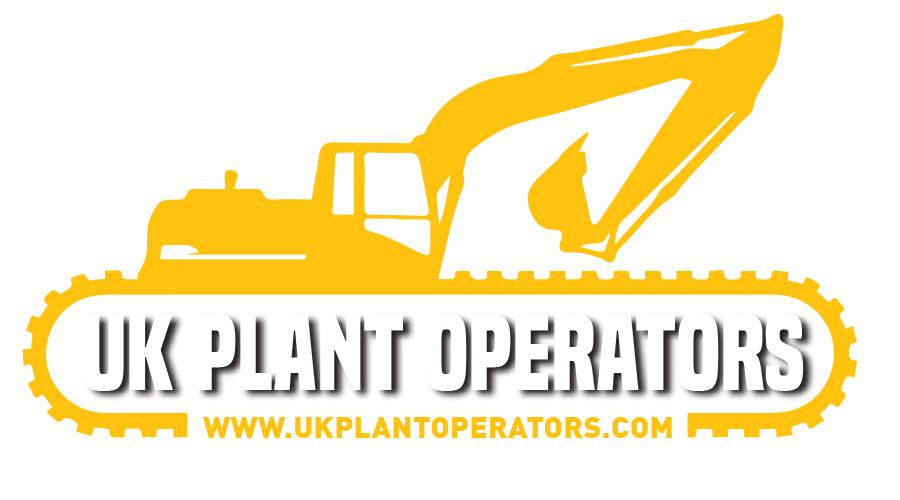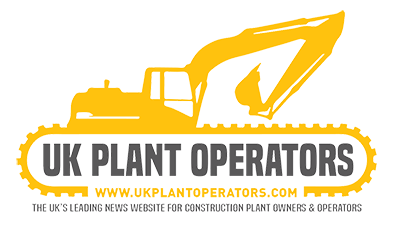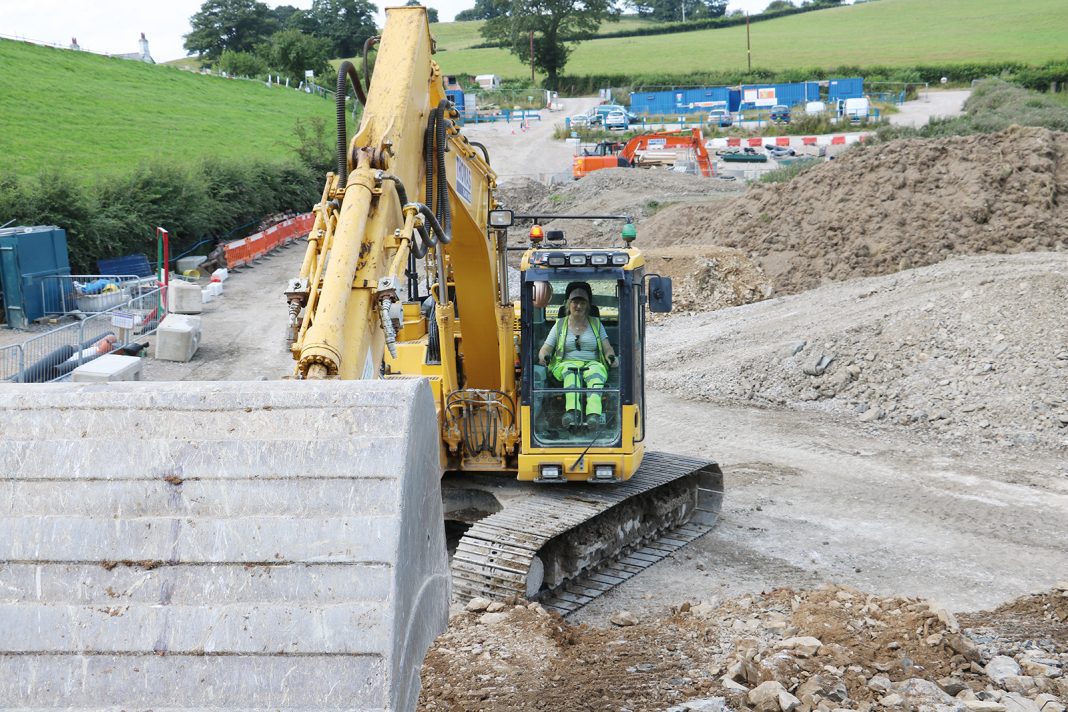![]()
We all had to start somewhere in the industry. Our resident operator expert, Lana Edwards, better known as Tracklass, tells us how she got involved in construction and how men need better aim in the toilet.
A warm welcome back to you all in what is proving to be a very wet and muddy start to 2020. I just hope that at some stage it’s going to start drying up so we can stop paddling around in mud up to our eyeballs. Huge respect to the guys on the ground who, every day, are out in some of the worse conditions that this winter has thrown at us.
Now in this article, UK Plant Ops have given me a bit of a free hand to write on any subject that might spring into my tiny little mind. So, I thought I would give you all a little insight into how I got into construction.
I have an agricultural background which I guess is a way of life and very much in the blood rather than a job. So, to make that move into construction was a massive step for me to make. On some of those bad days out on site, I often asked myself ‘hmmm did I make the right decision?’ The answer I always come back to myself with has always been a resounding YES! As with any line of work there is always going to be good days and bad days. I think there is a huge amount of folk on the construction sites from the farming communities simply because, as in my case, it is difficult to make the numbers work and make all the ends meet. I find this such a shame and so sad as a wealth of knowledge that is learned living and working on the land is not passed down to the next generations as it should be.
Start young
My father was an Agri Contractor, so tractors and machines were the norm in our family. I remember my brothers putting blocks of wood on an old grey Fergie and off they went – no way were they going to have all the fun, so I got a bit bigger block for the pedals and off I went. Good times indeed. My introduction to tracks came when I left school all those years ago. Those who watch my videos and see all my grey hair and wrinkles can tell how long ago that was. We had a County Crawler fitted with a blade based on the major (I think), a P55 County crawler that was a forestry spec along with a David Brown TD30. A lot of work we did was clearing and ploughing mountain sides with big trailed single furrow ploughs which was such time-consuming work. This certainly taught me very quickly what was and what wasn’t possible as any mistakes could well be your last
Along with the crawlers we had 4-wheel drive tractors fitted with dual wheels for doing the scrub clearance. Our father would put a track in up the mountain so we could get the tractors to the top. What I used to do was work sideways. I would start at the top and work my way down. However, every time the tractor was stopped it would slide a metre or two sideways. The experience taught me to read the conditions as well as I could, having that understanding of the machine and something I must never do is get complacent of the machine and job in hand. This is a frame of mind I carry forward very much with me today. The day you get complacent is the day it’s going to bite you in the back side.
Invaluable experience
I always remember a guy my father knew, who could certainly talk the talk, came and gave us some help one day. We put him on the TD30 to pull some bushes out about three quarters up this hill side. At the same time as he was doing this, I was doing my thing of cutting gorse sideways along. As the crawler gets halfway up this hill it stops. A few minutes go past, and it doesn’t move so I stop what I am doing and go down to him. The man is shaking like a leaf in a full-blown gale, stuck halfway up this hill trying to get this guy off the crawler was no mean feat I can tell you. Getting the machine down to the bottom of this hill along with the bloke in question was again not the easiest thing we did that day and after giving him some very sweet tea he was off and that’s the last we saw of him.
Another memory springs to mind. Again, my father had cut a track through this hill side. Up I trundle with the P55, plough in tow, and come off this track at 90 degrees to head downhill. As the crawler nose dives into a hole left by a tree the plough hits a boulder and upends the crawler with the end result of sliding down the hill about 6 or 7 metres and only quarter of the track carriage in ground contact before settling back down. That has been the only time
I have ended up at the bottom of the hill and just had to take a few minutes out before heading back up the hill to do it all again. These incidents when I look back very much taught me valuable lessons which are tucked away in the grey matter and make me the machine operator I am today. With everything I do with any machine on site these little bits of knowledge and experiences I have learned over the years are whirring around in my sub conscious.
From farm to site
As the years went along father bought a JCB 3C which is the machine I used at the beginning of my digger driving career. He then traded that in for a Case which I didn’t like too much – a lot lighter than the old JCB and horrendous hydraulic pipe work which was a nightmare to change out when a hose blew. The Case was then joined by a John Deere 310 built probably about 1975. The JD took some getting used to as it used a square configuration on the levers. Oh, what fun …NOT. We eventually ended up with a Daewoo 8t 360 on metal tracks. l loved driving that as I thought it performed well above its size. How I look back and wish I had taken photos of the machines through the years. Back then I would have needed a nail and a piece to slate to etch a picture but then those instamatic thingy bobs came along, gosh, I am starting to feel my age now. I guess though that it’s from those very early days of working on tracks which is why I feel comfortable working on site in the tracked diggers of various sizes today.
Due to my father retiring and a bereavement in the family along with finding myself in A&E with a burst appendix ( very nearly saw me off ) I decided I wanted a change of career from farming and odd-jobbing so while recovering I formulated a bit of a plan . The plan was to go and do my ticket but which also absolutely grieved me – a lifetime experience on machinery and I was going to have to pay X amounts of pounds for a piece of plastic to tell me that that I was capable of driving machines which I knew very well already.
I have sympathy and really feel for those operators who are coming into the job with no experience of machinery where they have to go and sit a course for however long , obtain the red card and then are basically thrown into the deep end on a live working site. I think that is a whole another story on its own.
Anyways once recovered I put said plan into action and I got hold of the training folk, booked a slot with them to give me a bit of training the “proper way” (more like to see what bad habits I had picked up through the years before doing the test) only to be told when I arrived , theory test at 11.00am and practical at 2.30pm should I pass my theory. Hells bells, now I was worried! I had been revising the theory (thankfully) which, if I remember rightly, totalled 212 out of a possible 216. Was quite happy with that! So on to the practical; I asked if what I was doing was that bit of training first before taking the test. “We shall see” was the answer back.
Taking the test
The test was on a 13 tonne Komatsu check all the fluids as I normally do. Fire up and let her warmup. I can remember heading off for the dig area through quite a tight gateway. Now I know why it was a bit tight, to see if the operator could get through without knocking the posts down. Judging by some of the marks on the posts they had led a hard life, battered and bruised, poor things – god help the guys on the ground that work with the drivers who battered the posts!
I did all the necessary stuff as instructed, digging the trench line, box on the end, load the dumper, backfill along with any other task the instructor detailed. At the end of the test I took the machine to its parking spot, brought it down to idle let the turbo spin down along with the pumps ( probably mentioned before one of my pet hates is seeing a machine of any type turned off at the key while at full revs).
It was such a great moment to be told I had passed and was to be issued with a card, albeit a red one and was ready to inflict myself on all the poor ground workers out there. To all those who are probably wondering at this moment, no I didn’t knock those posts over!
It’s from here that the real hard work started, trying to find a company that was brave enough to offer me a job. I went to a lot of local plant hire companies to offer my services only to hear nothing, no response to calls, emails, or even me in personal visits. I am ever thankful to Wyn Thomas of Thomas Plant in having the faith and trust in me to offer me that start in Construction
Now believe me, a female on a Construction site operating heavy plant is no easy place to be, particularly with a red card .One needs a very thick skin and coping with the realities of daily life around the construction sector has been a very steep learning curve. I am so thankful for those years of experience on the machines which helped to carry me through some quite tough times to earn my blue card (yes, another card to tell me that I can operate a machine).
Changing perceptions
I have come across Neanderthal man a few times let me tell you and he is alive and kicking around construction sites here and there. What quite gives him the right to make the life of a hire driver a complete misery I do not know. I doubt he would give his wife or daughter or mother the same grieve at home or maybe he does, who knows. Unfortunately, there have been one or two hires where I have had to ask to be taken off simply because the pressure gets too much. Without the support of site managers as I should have, (for example, I have been told “well he’s like that with everyone so it’s ok”) it very quickly becomes unbearable. Well it’s not ok and bullying, of any form, has no place at work.
Thankfully this is a very small minority of men out on site and in no way a bash at the hard-working decent blokes that I have had the utmost pleasure to work alongside.
It’s clear that some construction sites still need dragging kicking and screaming into the 21st century…. which nicely moves us on to the ladies’ loo situation on site, deep breath!!!
This can leave much to be desired. Sadly, even in 2020 the fact that Men and Women have wildly different plumbing set ups for bathroom breaks seems to be lost on some site managers. While I’m not advocating flowers and pot pourri in the loos, it surely stands to reason that toilets for male and female should be clean and hygienic as a matter of course.
Some of the bigger civil engineering sites I have been on usually have a fantastic setup with clean and sanitary facilities with both ladies and gents. Unfortunately, I usually must obtain the key from the manager every time I want to go to use the ladies. Do I want to let the site manager know every time I go to spend a penny? Nope, and what happens when the site manager goes off around site or leaves site? Well the number of keys I have had to get cut and pay for myself to avoid this is quite ridiculous currently. Some sites just have a thunder box which I am expected to share, now some guys must have a big distraction going on as they seem to pee everywhere bar down the bowl, maybe a target might help them take aim. And guys if you miss, please be sweet and wipe the seat.
Well I probably bored you all to tears by now so will say a huge thank you for all your support both here on UK Plant Ops and my Instagram and LinkedIn pages. Until next time be safe.























